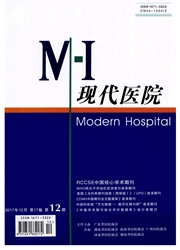

 中文摘要:
中文摘要:
目的了解口腔癌患者外周血免疫变化与临床结局之间的关系。方法收集郴州市某三甲医院40例口腔癌患者病例资料进行回顾性研究,分析治疗期间的外周免疫及肿瘤标志物变化及与临床结局的关系。结果在住院期间白细胞、中性粒细胞和单核细胞绝对数随治疗后逐步下降(从第1周到第11周的变化分别是(6.20±1.70)×10^9/L到(3.50±0.80)×10^9/L,(4.30±1.50)×10^9/L到(1.70±0.08)×10^9/L,(0.43±0.18)×10^9/L到11周(0.26±0.05)×10^9/L(均P〈0.05)。中性粒细胞的百分比也出现明显下降(从第1周到第11周的变化是65.2%±9.2%到11周的49.2%±4.9%)(P〈0.05)。但是淋巴细胞绝对数在下降到第5周后不再下降,并保持一定的水平。死亡的口腔癌患者淋巴细胞/中性粒细胞和淋巴细胞/单核细胞比值随病程延长的要明显低于治疗好转出院者(P〈0.05)。相关性分析发现淋巴细胞/中性粒细胞与癌胚抗原(CEA)之间存在负相关(r=-0.28,P〈0.05)。结论口腔癌患者外周血中淋巴细胞与中性粒细胞和单核细胞比值明显下降可能提示预后不良。
 英文摘要:
英文摘要:
Objective To explore the relationship between the change of leukocyte and outcome of oral cancer.Methods 40 patients who underwent surgery following cisplatine based chemoradiotherapy were enrolled in this study. The associations between the leukocyte subsets and the outcome of oral cancer were analysis. Results Total leukocyte,neutrophil and monocyte counts decline gradually during the during 11 weeks therapy( from( 6. 20 ± 1. 70) × 10^9/ L to( 3. 50 ±0. 80) × 10^9/ L,( 4. 30 ± 1. 50) × 10^9/ L to( 1. 70 ± 0. 08) × 10^9/ L and( 0. 43 ± 0. 18) × 10^9/ L to( 0. 26 ± 0. 05) × 10^9/L,respectively)( P〈0. 05). The percentage of neutrophil declined significantly( from 65. 2% ± 9. 2% to 49. 2% ± 4. 9%)( P〈0. 05). But the lymphocyte subset were gradually steady at the fifth weeks. Further analysis showed neutrophil and monocyte to lymphocyte ratios in death group of oral cancer patients were significantly lower than the control group( P〈0. 05).The neutrophil to lymphocyte ratio was negatively correlation with CEA( r =- 0. 28,P〈0. 05). Conclusion Neutrophil and monocyte to lymphocyte ratios declined obviously in oral patient may prompt poor outcome.
 同期刊论文项目
同期刊论文项目
 同项目期刊论文
同项目期刊论文
 期刊信息
期刊信息
